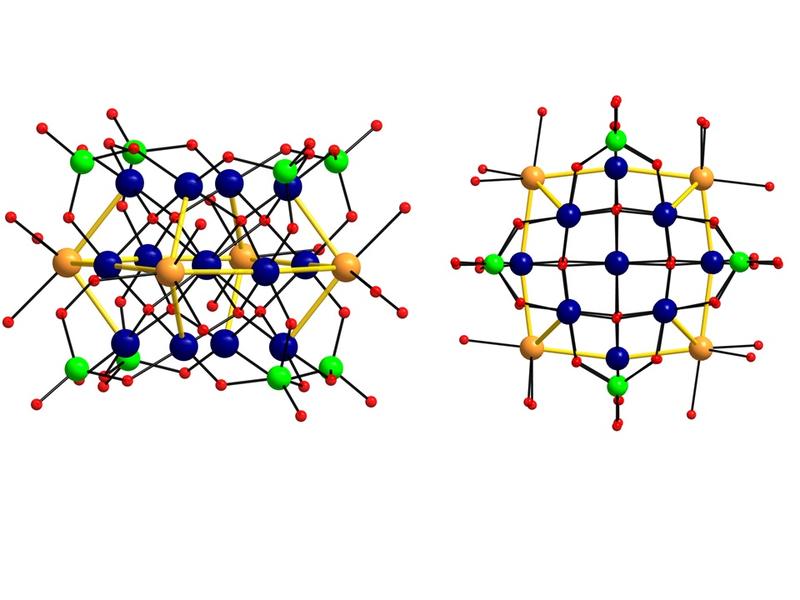

Structural representation of silver-capped polyoxopalladate {Ag4Pd13} in side view (left) and top view (right). Pd dark blue, Ag orange, As green, O red.
Kortz / Jacobs University
“Curiosity-driven research” is what Kortz calls his approach. “We try to produce new compounds. Initially, possible applications don’t play the dominant role; they follow automatically.” Curiosity drove him to experiment with precious metals such as palladium and platinum. In 2007, his research group discovered the class of polyoxopalladates; stable and molecular precious metal-oxo clusters (oxo stands for oxygen). These compounds are produced from simple starting materials in aqueous solution and have enormous potential as catalysts for industrial applications.
“If there is anything I’m really proud of, then it is this class of compounds. We have created something lasting, a new research area – that doesn’t happen very often,” says Kortz. The discovery found its way into textbooks; it attracted attention not only in the scientific community, but also in the chemical industry.
This is because these polyoxopalladates act as efficient catalysts, for example in the oxidation or reduction of organic compounds. The product yield or selectivity is increased at a lower expenditure of energy – particularly for energy-intensive industries, which means enormous cost savings. Currently, as part of a three-year industrial project with one of the world’s largest chemical companies, Kortz is doing research in this area. In just two years, four patents have been developed.
In the meantime, the original discovery has been extended to an entire family of polyoxopalladates. About 60 derivatives have been developed by Kortz and his team at Jacobs University; many of them have been patented. The latest discovery, which is reported in the current issue of “Angewandte Chemie” [Applied Chemistry], led to two new patents.
What makes it special is that the scientists for the first time have combined the two precious metals silver and palladium in the form of a molecular metal-oxo cluster. This is another highlight, says Kortz, because these compounds consist of a palladium-oxo core, capped by silver atoms. These compounds are ideal molecular precursors for the preparation of well-defined noble metal nanoparticles, which are highly relevant for industrial catalytic applications.
The team of Professor Kortz is already working on another new project, which is being financed by the German Research Foundation (DFG) for three years. It’s about so-called “MOFs”, metal-organic frameworks, whose pores can be used for gas storage/separation and catalysis. Materials researcher Kortz wants to combine the two classes of MOFs and polyoxopalladates, in order to build innovative heterogeneous catalysts. “They will be unique, that much we can promise already,” he says.
At Jacobs University, Ulrich Kortz is one of the pioneers. After stops in the USA, Italy, France, and Lebanon, he came to Bremen in 2002 – a year after the international university had opened its doors to students. He was able to participate in the design of his laboratory, but it’s not that he just likes to spend all his time there. He values teaching no less than research. “The combination is magic; always having an opportunity to work with talented young people sharpens the senses and keeps you young.”
He teaches his students not just in the seminar rooms; he also wants to get them excited about chemical research. Some of them have already been integrated into the laboratory activities of the Kortz workgroup starting with the very first semester. “The opportunity to work in a research lab is a dream come true for many Bachelor students and more than a few are even co-authors of publications.” Since 2002 Kortz and his team have produced more than 220 scientific publications and 13 patents.
Additional information:
German paper: http://dx.doi.org/10.1002/ange.201608122
English paper: http://dx.doi.org/10.1002/anie.201608122
http://ukortz.user.jacobs-university.de
http://www.jacobs-university.de
Questions will be answered by:
Ulrich Kortz | Professor of Chemistry
u.kortz@jacobs-university.de | Tel.: +49 421 200-3235
About Jacobs University:
Jacobs University is a private, independent, English-language university in Bremen. Young people from all over the world study here in preparatory, Bachelor, Master, and PhD programs. Internationality and transdisciplinarity are special features of Jacobs University: research and teaching don’t just pursue a single approach, they address issues from the perspectives of multiple disciplines. This principle makes Jacobs graduates highly sought-after new talents who successfully strike out on international career paths.
Contact:
Kristina Logemann | Brand Management, Marketing & Communications
k.logemann@jacobs-university.de | Tel.: +49 421 200-4454












